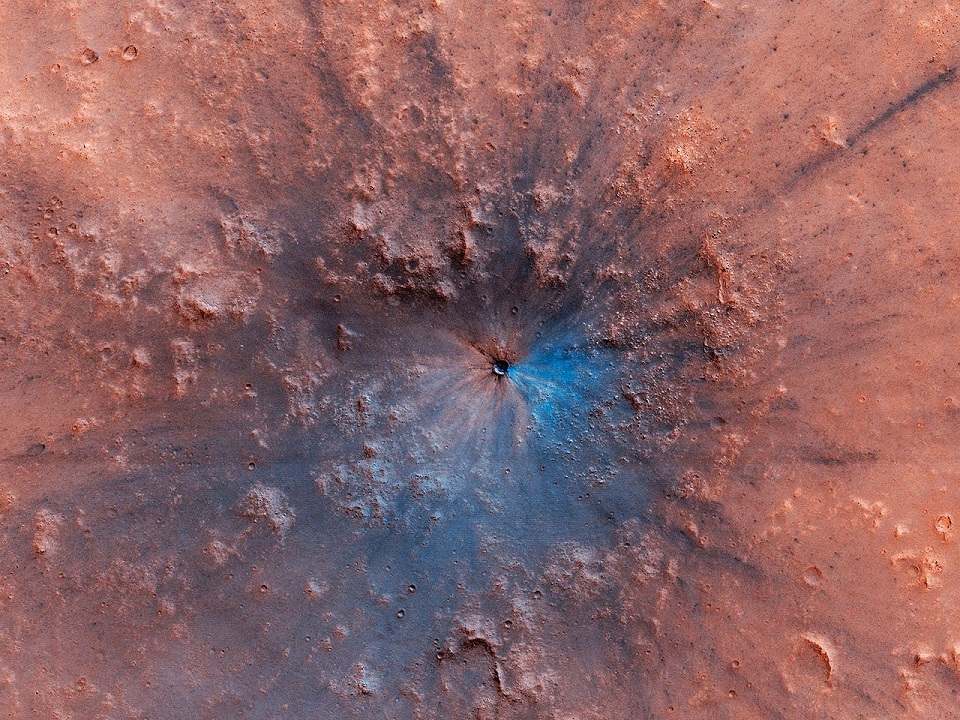
Space is not as empty as it seems. The Earth is constantly being bombarded by meteors. Each year about 50,000 tons of cosmic debris enter the Earth's atmosphere. Fortunately for us, most of this is dust and small meteors that burn up long before they get through the atmosphere. Meteorites – meteors that are large enough to reach the ground – are much more rare. There are fewer than ten observed meteorite falls per year. Meteorites large enough to create an impact crater more than ten miles across come along about once every million years. A meteorite has only struck and injured a person only a handful of times in recorded history, and only one of those has been confirmed without a doubt (In 1954, Ann Hodges of Sylacauga, Alabama got a serious bruise when a nine-pound meteorite came through her ceiling, bounced off a radio, and hit her in the thigh.).
It wasn't always like this. The early Solar System was a maelstrom of planets, planetoids, asteroids, meteors, and comets colliding with one another. Meteorites and comets used to strike the Earth thousands of times more often than they do today, and these impacts helped make the Earth what it is. The biggest of all the impacts happened 4.5 billion years ago, when the Earth and a Mars-sized planetoid named Theia mashed into one another. The impact was so violent that the Earth and Theia melted and mixed together, and the Moon was formed out of the matter that was blasted into orbit by the explosion.
Later, but still early in Earth's history, a steady rain of comets fell from the skies. When the Earth formed, this region of the Solar System was too hot for water to have accumulated, so the early Earth was a dry and barren planet. Farther out from the Sun, beyond where the asteroid belt is today, temperatures were cold enough for water to condense and freeze into comets and icy planetesimals. So many of these comets fell to Earth that the oceans were formed by their melting.
By about 2.5 billion years ago, the heavy bombarsment had ceased, but meteorites have continued to make their presence felt. A meteorite the size of Mount Everest is known to have caused the mass extinction that ended the age of the dinosaurs, and it's possible that other extinction events were helped along by meteorite impacts as well. On a smaller scale, there are more than twenty lakes on Earth that were formed by meteorite impacts, and meteorite falls have influenced oral storytelling traditions in areas as far apart as Australia, Argentina, and Estonia.
There are even meteorites in the fossil record. About 470 million years ago, two large asteroids crashed together near Jupiter. One of them was smashed to bits and sprayed all over the inner solar system. The Earth was in the path of the debris, so there must have been spectacular meteor showers, night after night, for more than a million years! Over 150 fossil meteorites from that collision have been found at the Thorsberg quarry near Lake Vänern in southern Sweden.
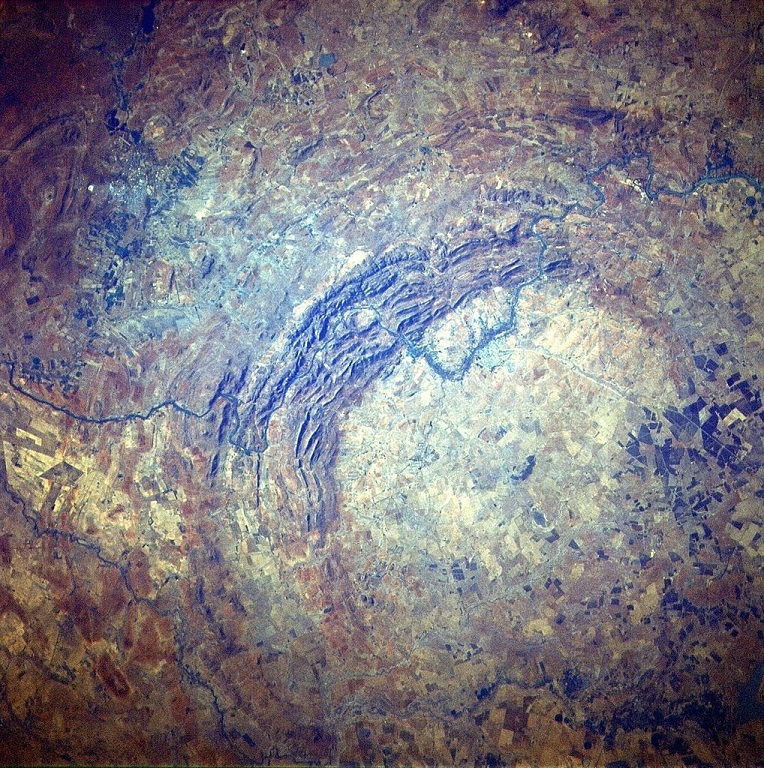
On Earth, most of the visible evidence for meteorite impacts has been erased by volcanic and tectonic activity, or by weathering and time. There are only about 190 confirmed major impact craters on Earth, ranging from the Vredefort crater in South Africa (about the size of Belgium) down to the 26 small craters made by the Campo del Cielo meteorites (none bigger than a football stadium). More than 50,000 meteorites have been found on Earth, but any meteor smaller than a bull elephant (7 tons) will get slowed too much by the Earth's atmosphere to make any sort of big crater. And many of the meteorites that are larger than that explode long before they hit the ground, resulting in a shower of stones rather than one giant hole. The pockmarked surfaces of the Moon and Mercury give a better picture of the destruction meteorites can cause. Without a thick atmosphere to slow or burn a meteorite, and without tectonic forces that thrust sections of their crust back under the surface, craters on Mercury and the Moon can survive for billions of years.
When a meteorite big enough to make a crater does hit, the meteorite is often completely melted or even vaporized in the impact. The crater itself is formed both by compression of the underlying rock, and by the surface rock being driven out of the crater's center. Most of the ejected surface piles up around the crater to form its rim, but major impacts can blast some of the surface rock all the way into outer space! Some of the meteorites that fall to Earth are from the Moon – lunar rocks that were exploded out into space when a giant meteor crashed into the Moon's surface. There are even meteorites on Earth that came from Mars in the same way, and there are probably a few meteorites on Earth that came from Mercury. The NWA 7325 meteorite may be one of these. Its chemical structure and magnetic properties are nearly identical to those of Mercury itself. The main thing that keeps us from being sure that it is from Mercury is that the rock that makes it up is estimated to be estimated to be 4.56 billion years old, and that's probably from a time when Mercury still had a molten surface that wouldn't have ejected rocks in an impact. Anthony Irving, one of the world's top experts in planetary meteorites at the University of Washington, said of it, "If it's not from Mercury, it's from a very interesting place."
There are special kinds of rock created by meteorite impacts. The general term for them is "impactites". One of the most famous types of impactites is Libyan Desert Glass, yellow, gem-like stones formed by a meteorite impact near Egypt and Libya about 26 million years ago. A particularly fine piece of Libyan Desert Glass was used to make a scarab centerpiece for one of Pharaoh Tutankhamun's most ornate pieces of jewelry. Tutankhamun was also buried with a knife made from meteorite iron!
If an impact blasts rock from the Earth's surface up into space or the upper atmosphere and it later falls back down to Earth, the rock is called a "tektite". Discovery of tiny "microtektites" all over the world in 66-million-year-old layers of sediment helped prove that it was a titanic meteorite impact that caused the extinction of the dinosaurs. A different impact about 790,000 years ago splattered tektites all over Australia, southern Asia and parts of Africa – as much as thirty percent of the Earth's surface was within the range of the tektite fall. Most tektites are glossy black on the outside, but for some of them, if thin enough slices are cut, a light shining through them appears yellow.

In a broad, barren plain of the Great Sandy Desert, Kandimalal rises like a suction cup on a giant octopus tentacle. 100 feet high, more than half a mile wide, it looks every bit as unearthly as the meteorite that made it. Like most meteor craters, its shape is a circle, and from the rim to the crater floor it is nearly 200 feet deep. The Jaru people tell a Dreaming-story of a giant, rainbow-colored serpent that made the crater as it rose out of the Earth. On maps it is called the Wolfe Creek Crater, and the road to it is a bumpy dirt track extending 80 miles off from the Great Northern Highway. If you go, you'll want a four-wheel-drive vehicle, and be sure to bring lots of water.
The most recent research suggests that Kandimalal is about 120,000 years old, and that makes it an unusual survivor. Most well-defined impact craters are less than 100,000 years old, since weathering and plant-growth steadily wear most craters down. The Barringer Crater in Arizona, known widely as just "Meteor Crater", is only 50,000 years old. Several older craters remain as lakes, such as the 220,000-year-old Tswaing crater in South Africa, the million-year-old Bosumtwi crater (the only natural lake in Ghana), and the 3.5 million-year-old El'gygytgyn crater in northwest Siberia.
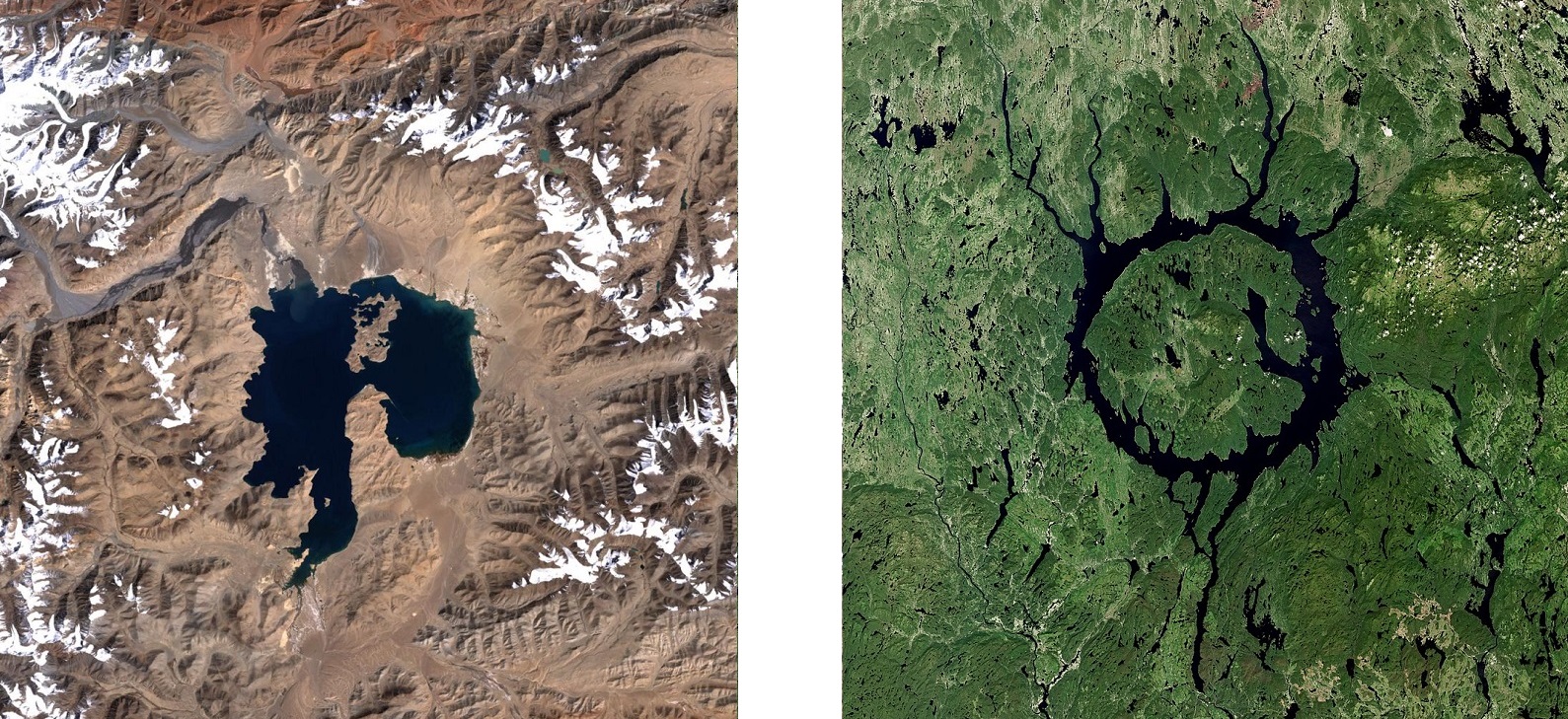
The well-defined craters are young, but the large craters are old. On a geological timescale, weathering forces "quickly" erode the rims of craters and fill their basins. Only the very large craters are still evident after long periods of time have passed, and the rarity of large impact events explains why there are no "new" large craters. No impact crater in the last 800,000 years has been much more than a mile across, and there have only been two craters in the last 30 million years that have been more than 10 miles across. El'gygytgyn, about 11 miles wide, is one. The 32-mile-wide Karakul Crater in the Pamir Mountains of Tajikistan is the other. Estimates of Karakul's age vary, but it is somewhere between 5 and 25 million years old. The other 13 known craters more than 25 miles wide are all older. Two of the three largest known craters, 185-mile-wide Vredefort (South Africa) and 80-mile-wide Sudbury (Canada), are about 2 billion years old. The youngest truly giant crater is Chixulub, near the Yucatan Peninsula of Mexico. It has been dated to 66.1 million years ago.
There are many more craters on Earth that have yet to be discovered. Some sites have been discovered that may be impact stuctures, but they have not yet been confirmed as such by the discovery of shatter cones, impact-compressed rock, or other impact-related evidence. In addition to the 190 confirmed craters listed in the Earth Impact Database, there are at least 65 other sites considered to be "probable" craters, and another 65 that are "possibles". One important crater that may have just been found is the one associated with the Australasian strewnfield. About 790,000 years ago, a large meteorite hit somewhere in the southern hemisphere and blasted more than 10,000 tons of rock up into the sky. The resulting rain of tektites – likely more than a billion of them – are scattered all over Australia, Southern Asia, islands in the Indian Ocean, and parts of Africa. The fall area spans up to 30% of the Earth's surface. In the December 30, 2019 edition of the Proceedings of the National Academy of Sciences, Kerry Sieh and a team of researchers presented "stratigraphic, geochemical, geophysical, and geochronological evidence that the ∼15-km diameter crater lies buried beneath a large, young volcanic field in Southern Laos."
Asteroid 4 Vesta used to be round. With a mass of 259 million billion tons, it is the second-largest asteroid and it is large enough for gravity to have pulled it into a spherical hydrostatic equilibrium. If it was stiil round it would be, after Ceres, the second dwarf planet in the asteroid belt. But about a billion years ago, a giant object about one-tenth of Vesta's size smote its South Pole such a mighty blow that the entire asteroid was turned all lop-sided. More than one percent of Vesta's mass was excavated from the huge Rheasilvia Crater and flung into space. Large pieces of the ejected rock became the Vestian asteroids, and smaller pieces were scattered every which way, with many of them falling to Earth and becoming the HED meteorites. The Rheasilvia crater is 314 mi in diameter, 95% of the average diameter of Vesta itself. Vesta is the asteroid belt's last remaining protoplanet – a planetary body with an interior fully differentiated into core, mantle and crust, formed in the early stages of the Solar system's history – and its internal differentiation meant that the impact formed giant wrinkles in its surface around the equator. The largest of these troughs is Divalia Fossa, which rings nearly the whole of Vesta. Ranging from 6 to 13 miles wide and up to 2 1/2 miles deep, it exceeds even the Grand Canyon in size. The mountain at center of the Rheasilvia crater, formed by post-impact gravitational collapse of the surrounding crater, is the Solar System's tallest peak.

The Rheasilvia event is not the only impact to have made major changes in the target body. A 2006 study of planetary-formation models by Caltech's Alex Alemi and David Stevenson suggest that Venus may once have had a moon. Like our moon, it was formed when an immense protoplanet collided with Venus. But then a second cataclysmic impact disrupted the Venusian system, reversing the direction that Venus spins on its axis, slowing its rotation enough that its day is longer than its year, and altering its gravity to the point that the new moon spiraled in to crash into and reunite with the rest of Venus' mass.
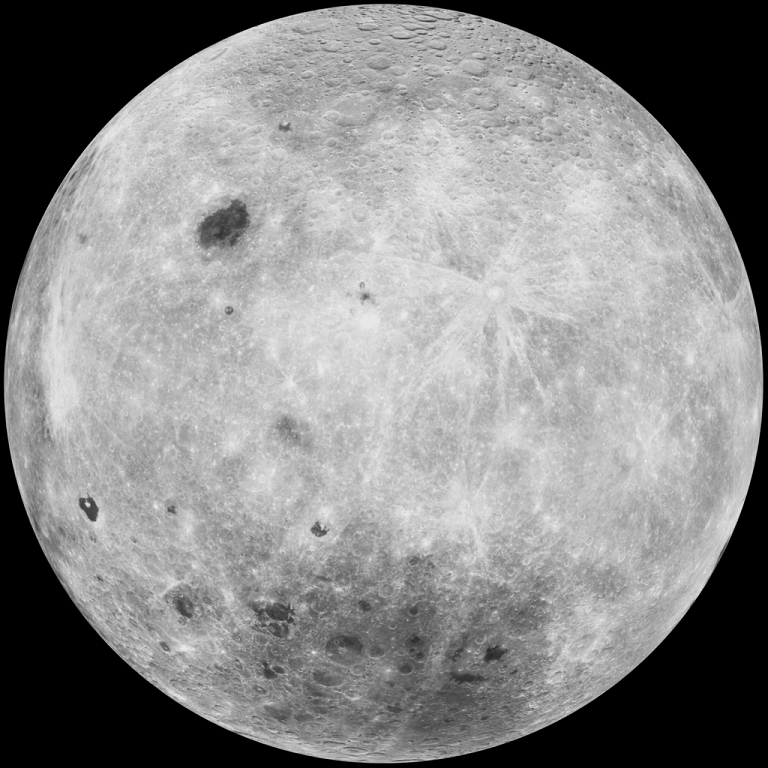
The Moon displays the effects of meteorite impacts in a particularly vivid manner. In addition to there being more than 300,000 1km-or-larger craters visible on the side of the Moon that faces Earth, the dark lunar maria that give the Moon its distinctive two-tone appearance are the result of volcanic lava flowing into giant impact basins. The impacts themselves may have triggered or facilitated the volcanism but the average 100-million-year delay between the impacts and the lava flows make that doubtful. There is also a hypothesis that the Moon was subjected to a cataclysmic rain of meteorites around four billion years ago. The Late Heavy Bombardment, as this is called, would account for how samples of lunar rocks brought back by astronauts showed a clustering of impact-melt ages around this time period, despite the fact that they were collected from widely-separated areas of the Moon by the different Apollo missions. More recent analysis suggests that the clustering of ages actually shows the effect of a single titanic impact, when an object three times the size of New Jersey created what is now the Mare Imbrium and scattered impact-melt rocks all over the Moon's surface.
The Mare Imbrium isn't even close to being the largest impact crater on the Moon. That honor goes to the South Pole-Aitken (SPA) basin, which is 1,600 miles in diameter and 8 miles deep. Buried far underneath it is a hunk of metal five times the size of Hawaii's Big Island. This may the remnant of the behemoth that made the crater. The absolute age of South Pole–Aitken basin is unknown, but it is thought to be at least as old as the other lunar maria. Finding out whether it is the same age or older than the Mare Imbrium would help decide whether there really was a Late Heavy Bombardment, or if the rate of meteorite impacts declined more steadily from an early-Solar-System maximum.
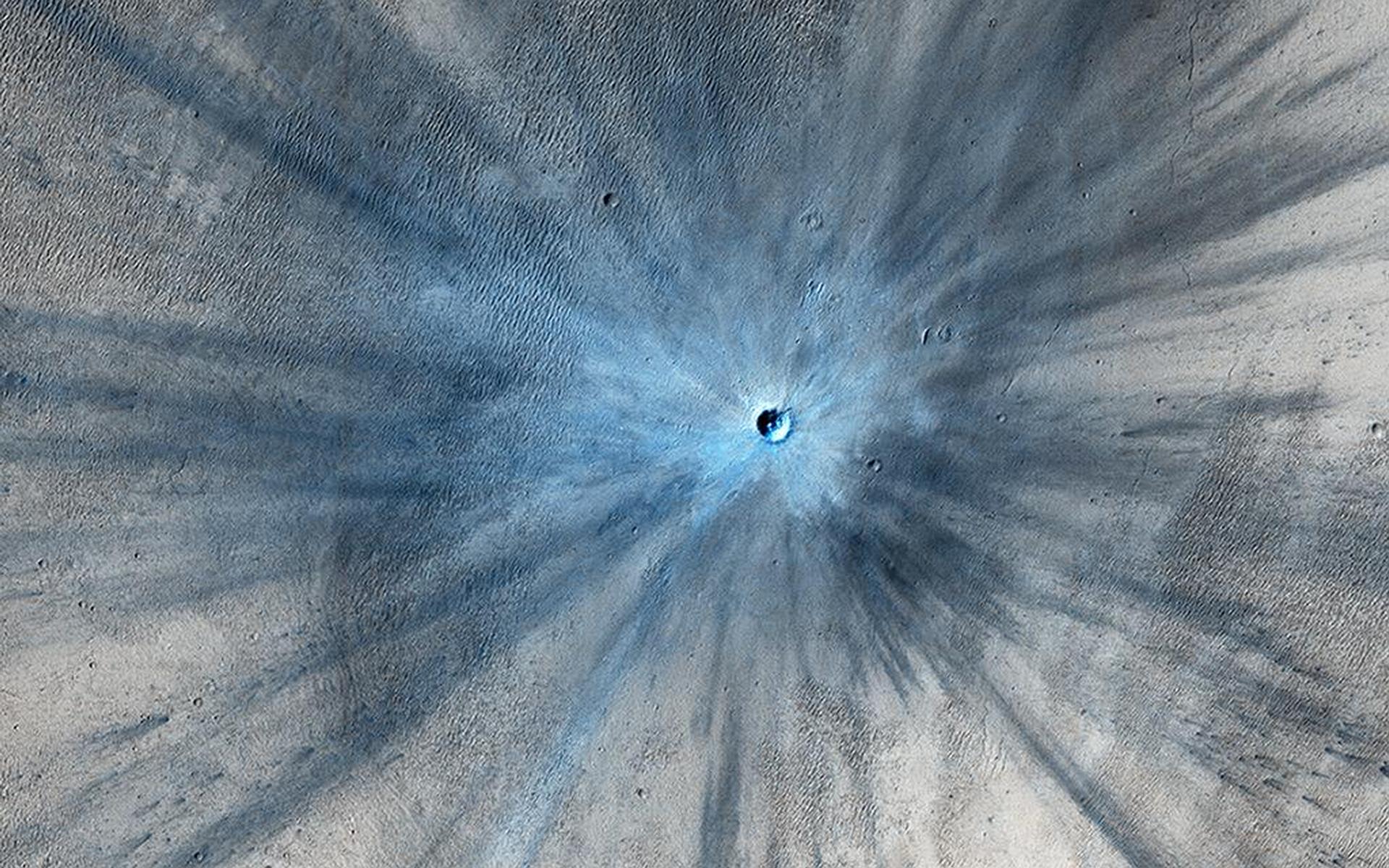
The surface of Mars is similarly affected. Stuart Robbins and Brian Hynek, researchers at the University of Colorado, Boulder, spent more than four years analyzing Mars photographs and outlining crater rims. By the time the finished, they had compiled a database of 650,000 Martian craters with a diameter of 1 kilometer or greater. Some of the newest craters show the spray of materials scattered by the impacts, which makes for some very dramatic photographs.
Studying the impact craters on Mars has helped us develop an estimate of the total amount of water still on the planet. By analyzing the types and shapes of the craters, scientists have been able to determine that the frozen, icy layer of Mars varies from around four-fifth of a mile thick at the equator to two miles thick at the poles. This suggests that there is enough water to cover the entire surface of Mars with an ocean 650 feet deep. This is very good news for future space colonists!

In comparison to Mars, there are relatively few impact craters on Venus. Because all of Venus' water was boiled off and lost to space billions of years ago, and because Venus doesn't have giant tectonic plates the way the Earth does, Venus has no efficient way of dissipating the heat that builds up from internal radioactive decay. Once in a while, the last time about 500 million years ago, the entire surface of Venus melts and a new crust forms as the heat dissipates. Remember that the next time someone tries to sell you Venusian real estate! Most of the craters Venus does have are more than two miles in diameter, because Venus' thick atmosphere burns up or explodes meteors that would otherwise cause smaller craters.

Despite being closer to the sun, Mercury is not as hot as Venus. Being smaller, it generates less internal radioactive heat. And it has a magnetosphere, so it is somewhat shielded from the Solar Wind. Cooler temperatures at the poles and at the bottom of impact basins have also allowed it to retain a significant amount of water. Since its surface doesn't get melted and reformed the way Venus' does, and because it has a very thin atmosphere, the surface of Mercury is festooned with craters and maria the same way the Moon is. No comprehensive count of Mercury's craters has been done, but there are likely hundreds of thousands. The largest is Caloris Basin which is large enough hold the entire state of Texas. As with Venus, the Caloris impact may have affected Mercury's rotation on its axis. Scientist believe it was once taidally locked to the Sun, the way the Moon is to Earth, but an impact may have disrupted that and resulted in Mercury rotating three times on its axis for every two orbits it completes around the sun.
Many asteroids besides 4 Vesta have visible craters, as do the moons of Jupiter and Saturn. Saturn's moon Mimas has a large crater named Herschel that makes it look eerily like the Death Star from Star Wars.
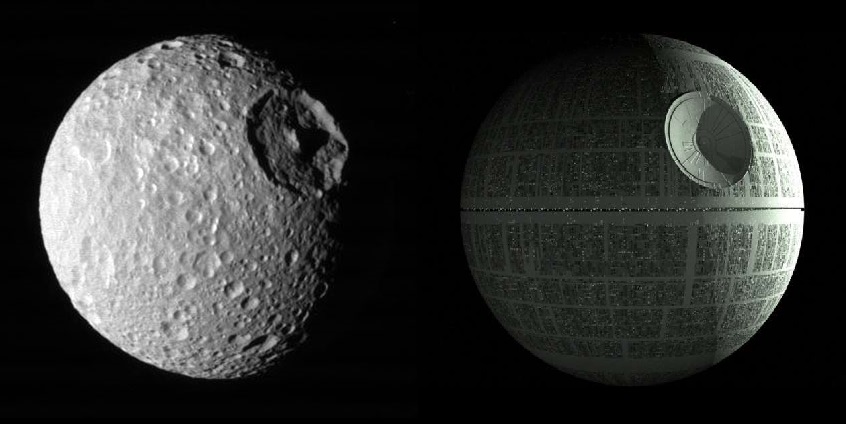
Fewer impact craters are to be expected the farther one gets from the Sun, as the objects whizzing around the early Solar System would have been less concentrated out there. Nevertheless, impact craters were observed during the New Horizons flyby of the Pluto system. There were very few small ones (below 6 miles in diameter). This suggests that the nearby Kuiper Belt contains mostly larger objects rather than myriads of tiny ones.
The four gas-giant planets swallow any meteor that comes close to them, and the density and violence of their internal atmospheres would probably destroy any meteor before it made a crater. However, we were able to see a particularly dramatic impact on Jupiter, when pieces of comet Shoemaker–Levy 9 hit the planet in 1994. Images of the impact show vivid brown spots at the points of impact.


When a large meteorite hits the Earth and makes an impact crater, it shocks, compresses, melts, and sometimes ejects rock at the impact site. A characteristic feature of impact craters is shatter cones – conical structures that form when rock is subjected to pressures greater than 300,000 pounds per square inch. Nuclear explosions are the only other thing that can cause shatter cones, so finding them usually confirms that a given geological structure is an impact crater. The meteorite impact that created the Slate Islands archipelago in northern Lake Superior also created the record-largest shatter cone, one more than 32 feet long. This impact may have been part of the Ordovician Meteor Event.
Rocks that are formed or altered by a meteorite impact are called "impactites". If the impactite is exploded into space or the upper atmosphere and falls to Earth again, it is referred to as a "tektite". A major impact event, like the one that wiped out the dinosaurs, will leave tiny tektite traces in sediment layers around the world. These tiny glassy beads are often called "microtektites". The sediment layers associated with an impact event are also high in the element iridium, which comes from the meteorite that was vaporized by the impact. Finding iridium at a site is another way to confirm that it is an impact crater.
One of the most famous, and also most beautiful, kinds of impactite is Libyan Desert Glass. Around 29 million years ago a large meteorite exploded directly over the Eastern Sahara, about where the border between Libya and Egypt is today. The force of the explosion was 200 times as great as occurred in the Chelyabinsk airburst of 2013, and 20 times as great as the airburst over Tunguska, Russia in 1908 that wiped out about 80 million trees over an 830 square mile area of forest. The definitive proof that Libyan Desert Glass was created by a meteorite came with the discovery of reidite, a form of zircon that can only form as a result of pressures too great to be caused by anything other than a meteorite. Thousands of years before the rise of the Egyptian Empire, hunter-gatherers in the Eastern Sahara would travel up to 125 miles to obtain Libyan Desert Glass that they could make into sharp blades, much the same way obsidian was used in other places. The ancient Egyptians valued Libyan Desert Glass, too. One of the most ornate pieces of jewelry found in Pharaoh Tutankhamun's tomb is a pectoral whose centerpiece is a large scarab made of the Glass.
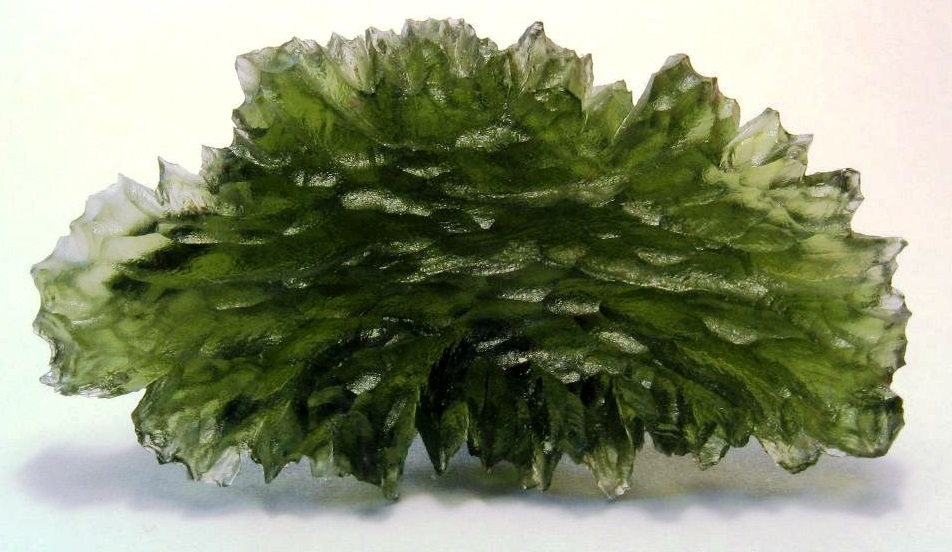
Another famous and beautiful impactite type is moldavite. This bottle-green, glass-like mineral was formed almost 15 million years ago in the impact that created the Nördlinger Ries crater in western Bavaria. Moldavite is classified as a tektite, as it is found widely scattered up to 280 miles away from the original crater. Moldavite is the only impactite commonly used in jewelry, as it is just hard enough to cut into faceted gems. High-quality moldavite pieces can have a delicate fern-like pattern highly prized by collectors.
The Nördlinger Ries event also created another type of impactite – suevite. Different types of suevite are found in impact craters around the world. Suevite is a mixture of impact-melted rock and unmelted or partially-melted inclusions ("clasts") of the rock present before the meteor hit. Nördlingen's town hall has a stairway leading to a portal made entirely of suevite.
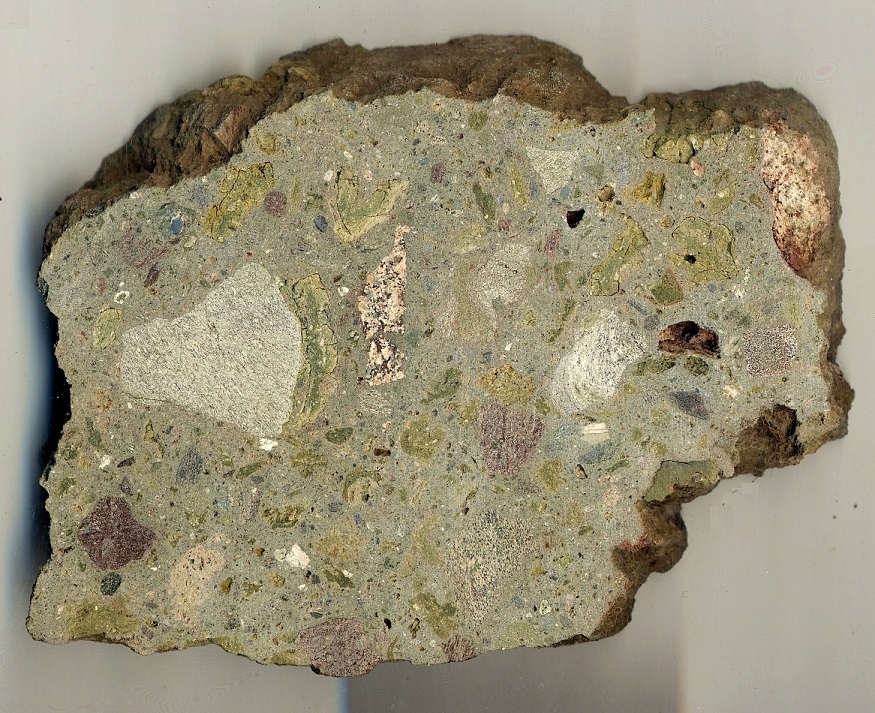
There are three other main concentrations of tektites besides the moldavite strewnfield around Nördlinger Ries. The largest is the Australasian strewnfield, more than a billion tektites scattered across almost a third of the Earth's surface. The second largest is the North American tektite strewn field, which stretches from Massachusetts to Barbados, covering about 4 million square miles. The North American strewnfield was caused by an impact about 35 million years ago that made North America's largest crater, the Chesapeake Bay crater. Two common types of tektites from this strewnfield are green Georgiaites (from Georgia, as the name suggests) and black Bediasites, which are found in Texas. Finally, there is the Ivory Coast strewnfield, which is mostly microtektites. Larger tektites from the Ivory Coast are rare and valuable.
There are two kinds of rock with entirely terrestrial origins that are often found in collections along with impactites. These are fulgurite, formed by lightning striking sand, and trinitite, the mildly radioactive desert glass formed in the world's first atomic bomb blast at the Trinity Site in New Mexico.

The Hell Creek Formation in the Midwestern plains of North America has some of the richest fossil beds in the world. At least thirty different dinosaur species have been found in an area that encompasses eastern Montana and Wyoming, and the western half of North and South Dakota. The area is particularly rich in triceratops and tyrannosaurus fossils, and an Edmontosaurus found there in 2000 is the most complete hadrosaurid dinosaur fossil ever found. Other vertebrate fossils have been found in abundance, including pterosaurs, crocodiles, champsosaurs, turtles, snakes, lizards, frogs and salamanders. Some bird and mammal fossils have been found there, and the formerly-marine areas of the formation have offered up mosasaurs, plesiosaurs, and a wide variety of fish fossils. Ammonites and other invertebrate fossils are plentiful, as are fossils of a wide variety of plants. All over the formations rocky outcroppings, this abundance and diversity of life forms stops dead in a thick, brown layer of barren clay. For a span above the layer, in the Fort Union formation, fossils are almost completely absent. It's like Cretaceous life was having a big party, and everyone was having a great time until someone showed up with a giant flamethrower.
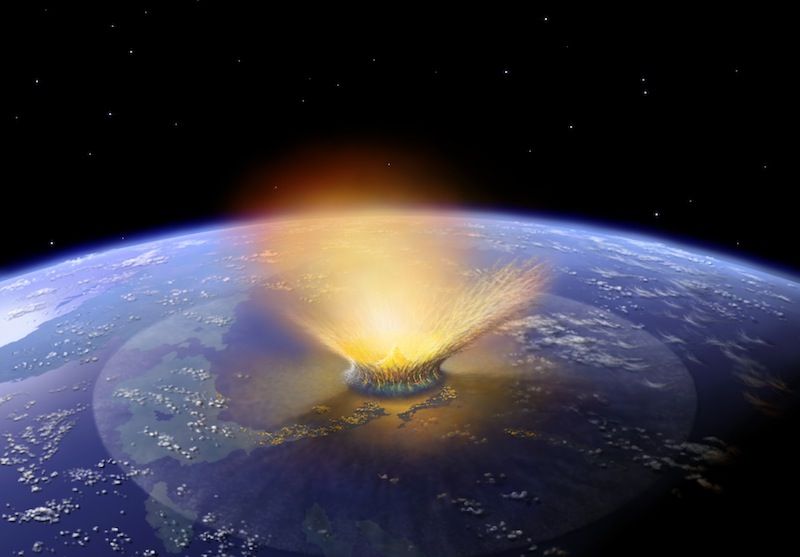
All over the world, in the rock layers that mark the transition from the Cretaceous to the Paleogene period (the "K-Pg boundary"), the situation is the same. At the Trinidad Lake State Park in Colorado, the boundary layer is almost an inch thick and light gray. At Woodside Creek in Marlborough, New Zealand, it shows up as a thinner layer of iridium-rich sediment (the element iridium is rare on Earth, but common in meteorites). The layer is thick and very light gray in the Geulhemmerberg mine in the Netherlands. The highest amounts of iridium are found in the cliffs at Stevns, Denmark. Sediments near K-Pg boundary layers in Japan and Antarctica show evidence of a sudden fall in sea level, indicating that a nuclear-winter-like plunge in temperatures caused a spike in polar ice formation.
Dinosaurs first appeared in the Triassic period, between 233 and 243 million years ago. After the Triassic–Jurassic extinction event 201.3 million years ago they became the dominant life forms on the planet, and their reign continued unbroken for 135 million years. All that changed in one day just over 66 million years ago. A giant asteroid came screaming through the skies over Mexico. It was at least six times as big as Mount Everest – possibly even a hundred times as big! It hit the Earth just off the coast of the Yucatan Peninsula and immediately blasted a 93-mile-wide hole in the ground, up to 18 miles deep. The blast had the energy of a billion Hiroshima bombs. Parts of the mushroom cloud that rose halfway to the Moon and fanned out over North America were hotter than the surface of the sun. The air within fifteen hundred miles of the impact became red hot in the shock wave and debris storm. Whole forests came alight with devastating fires. Red-hot globs of glass rained down all over North America, spreading the fires wherever they landed. The super-hot clouds traveled to the far side the world, igniting fires all across the Indian subcontinent. Huge amounts of rock were blasted into outer space. The Moon and Mars were splattered all over with the ejected rocks, and tens of thousands of tons of the debris eventually landed on the moons of Jupiter and Saturn.
Tsunamis more than three miles high rolled out from the impact site, one of them carrying ocean sand 600 miles inland into West Texas. Coastlines were torn up, stripped of hundreds of feet of rock that were driven far into the interior. As the waves receded they jumbled up the surface rock even more, pulling huge piles of deposits into the Gulf of Mexico. Earthquakes and flooding were recorded in the fossil deposits almost 2,000 miles away in North Dakota. The impact even triggered a massive increase in volcanic eruptions in the Deccan Traps of western India.
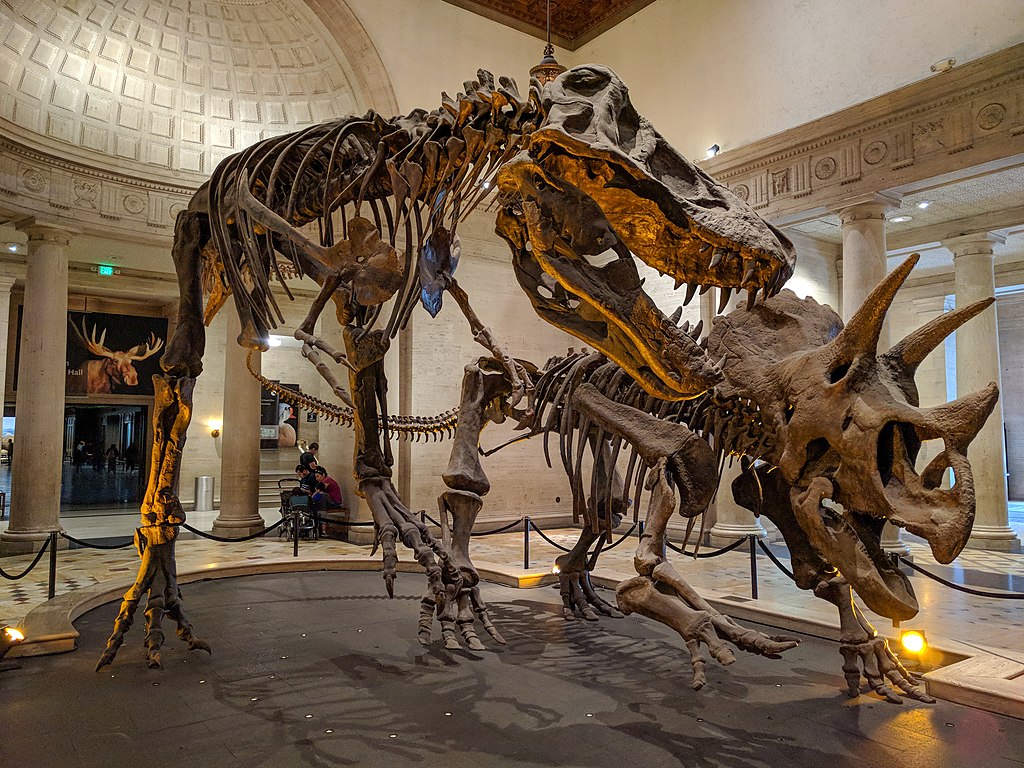
For the dinosaurs and other animals and plants alive at the time, the location of the impact could not have been worse. The shallow seas near the Yucatan were rich in gypsum, so between 200 and 450 billion tons of sulfur carried up into the sky. Nearby, the vast oilfields of Mexico were set aflame. The sulfur and soot from the fires blotted out the sun, and as the fires died down the Earth was plunged into a terrible winter, where temperatures all over the globe remained below freezing for up to sixteen years. All of the sulfur eventually came back to the surface in the form of acid rain, melting the leaves of the remaining plants and rapidly acidifying the oceans. Marine ecosystems were devastated.
75 percent of the species on Earth were wiped out. But that number fails to express the magnitude of the disaster. For every million organisms alive before the Chixulub meteorite hit, only one survived in the times that followed. The larger animals suffered the worst. Except for a few crocodiles and a few turtles, no four-legged animal over 50 pounds survived. The dominance of the dinosaurs worked against them; many had grown to sizes that made it impossible for them to find enough food in the aftermath. A few of the mammal species, and a few of the birds, were small enough to scratch out a living until the plants began to grow again. Considering the extent of the carnage, the Earth's ecosystems bounced back surprisingly quickly. Life returned to the seafloor around the crater within 30,000 years. Over the course of the next 500,000 years, larger and larger animals began to appear. Before the impact, some mammals were as large as raccoons. After the wave of extinction, the largest remaining mammals were about the size of rats. Within 100,000 years, raccoon-size mammals were back. 300,000 years after the impact, some were the size of beavers. 400,000 years after that, some mammals reached 100 pounds or more. Full recovery of the marine environments was much slower, taking as much as five million years. In all cases, the new ecosystems that arose were tremendously different from what had existed before.
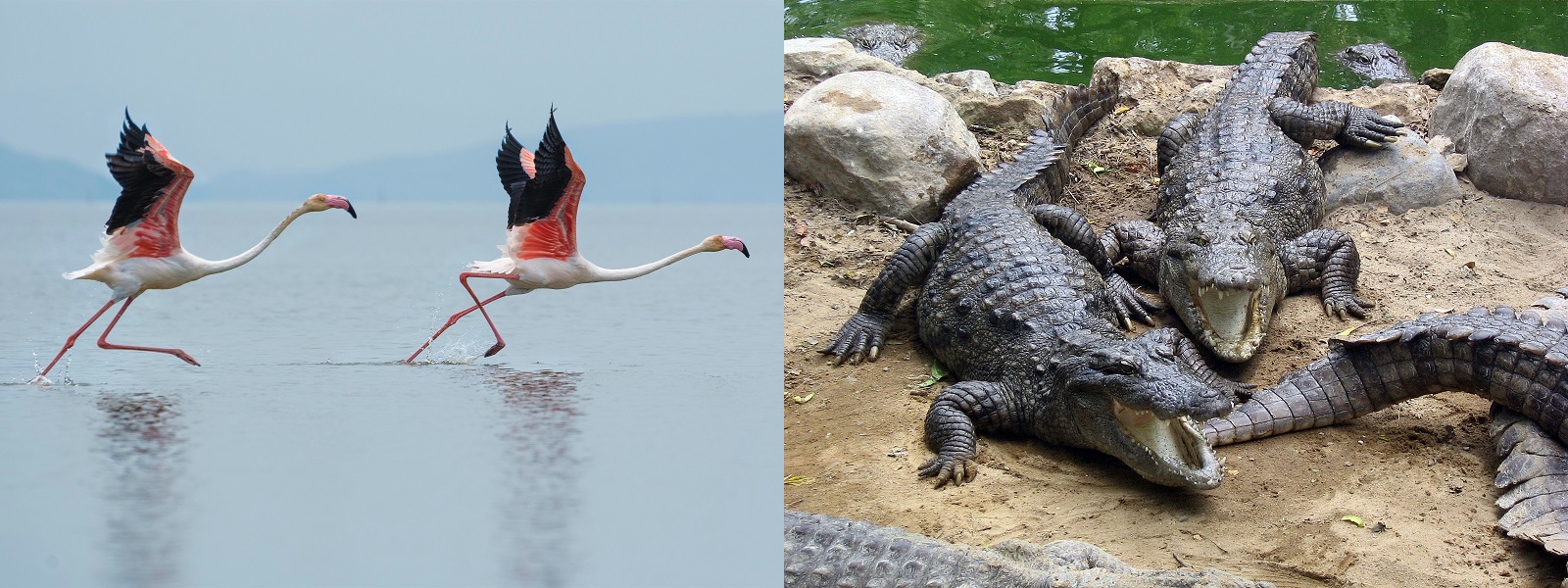
Fortunately for us humans, meteorites like the Chixulub impactor don't come along very often. An impact that devastating is expected to occur only once, maybe twice, every billion years. The biggest impact since Chixulub happened about 35 million years ago, when the Popigai crater was made in Siberia. The Popigai impact was probably the trigger for another extinction event, between the Eocene and Oligocene Epochs. That event was minor in comparison to the end-of-Cretaceous extinction. Marine ecosystems were hit relatively hard. About 90% of the mollusc species in the waters off the eastern United States went extinct, but that is a particularly severe example. Aside from Chixulub and Popigai, no extinction events have been linked to meteorite impacts for at least the last 100 million years. For long into the foreseeable future, meteorite impacts are much more likely to be a source of scientific knowledge and inspiration than to be a cause of devastation and death.

